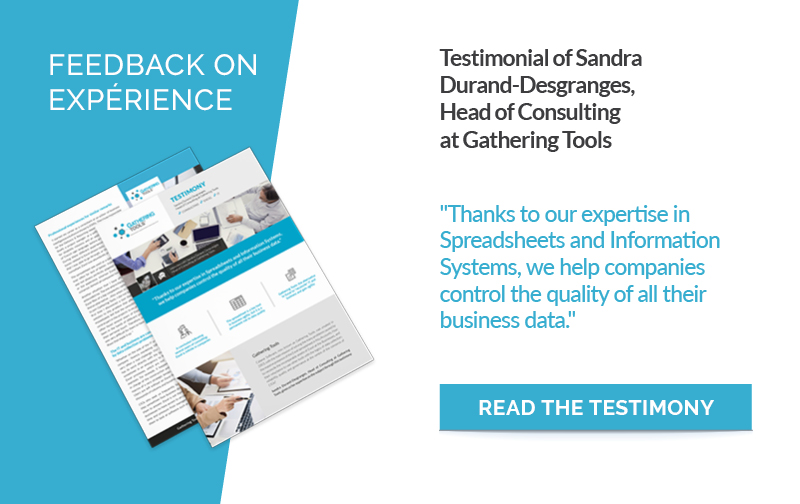The headquarters of big companies need reliable information, based on data from the field, to make decisions, to be equipped with monitoring indicators, to meet reporting obligations.
But the bigger the companies, the more their strategic decision-making centres are distant from the production units, hierarchically, but also, geographically. In these conditions, setting up an operational process of exchange and feedback is a real challenge. This is due to large difference in the granularity of the available data. But why is it so difficult to go looking for information at the level where it is produced?
The granularity of data: a real challenge for big companies
 To source their monitoring indicators, the headquarters of big groups naturally turn to their production units. They are in the best position to put reliable information on the ground. So far so good!
To source their monitoring indicators, the headquarters of big groups naturally turn to their production units. They are in the best position to put reliable information on the ground. So far so good!
In practice, it gets complicated. The operational units have a lot of data. For example, to drive their production, they build their own indicators, most often via “home” processes based on Excel. Thus, a factory manager calculates his energy consumption, from the data reported by each workshop, where they are based on the consumption of each machine or workstation. But, the problem is that these data do not match the specific expectations of the seats for a simple reason, it’s not their purpose.
In practice, most of the data that headquarters requires already exist in the production units, but in an operational form, they are very detailed and their organisation was designed to facilitate their daily monitoring. The headquarter, for its part, does not need such fine information. It manages the group and, unless a strategic event justifies its attention, the data requested from the local entities will be aggregated. This aggregation will facilitate both inter-entity comparisons and data exchange.
And the phenomenon is amplified with the size of companies. The bigger the companies, the greater the differences in data granularity between decision-making and operational centres.But in terms of process, differences in granularity pose a simple problem: who will pay?
Obviously, from the point of view of headquarters, the simplest way would be to receive perfectly homogeneous data, otherwise the cost of treatment will be directly proportional to the size of the organization. But asking each operational unit to repeat it data work to meet the demands of headquarters also has a cost. The resistance to change users who rightly believe that their number one priority is the production, not the reporting.
The IT Department is facing a non-predictive data workflow
 Faced with these difficulties, the headquarter will be tempted to approach the IT Department, both to develop a collection process and to make it accepted by the entities. But, beyond this problem, which after all, concerns a big number of projects which is another obstacle, but this time is a technical one. The latter will quickly get in the way of headquarters where very often nobody knows the identity of the user who could produce the correct data.
Faced with these difficulties, the headquarter will be tempted to approach the IT Department, both to develop a collection process and to make it accepted by the entities. But, beyond this problem, which after all, concerns a big number of projects which is another obstacle, but this time is a technical one. The latter will quickly get in the way of headquarters where very often nobody knows the identity of the user who could produce the correct data.
The data workflow is non-predictive. It is impossible to know in advance all the worksites of the company, the details of all its entities or the perimeters of responsibility of each employee. Without being able to list all the stakeholders involved, how to implement a solution?
It would obviously be possible to start the project by listing all the users involved down to the finest level, but then the acquisition and maintenance costs of this user repository could well exceed the benefits generated by the project. We would be a long way from an agile data collection solution, and users would be likely to return to their old demons, Excel + Mail.
GT, the most direct path to raw data
 To structure efficient data exchange processes, Gathering Tools implements several principles. First, it ensures that all the stakeholders involved work on the same set of standards – which is essential for obtaining quality information. Specifically, with Gathering Tools, headquarters will provide a secure template, with consistency check functions, to operational centers. The latter will inform him based on the information they have at their disposal.
To structure efficient data exchange processes, Gathering Tools implements several principles. First, it ensures that all the stakeholders involved work on the same set of standards – which is essential for obtaining quality information. Specifically, with Gathering Tools, headquarters will provide a secure template, with consistency check functions, to operational centers. The latter will inform him based on the information they have at their disposal.
Second main principle, the user in an operational center does not have to generate new data. With Gathering Tools, it synchronises information it already generates with the demands of the headquarters. It goes even further. It connects all of its local data management environment in Excel at the operational level with the headquarters template, where all data transformations can be performed by spreadsheet functions. And, this work is obviously only to be done once. During the following iterations, all this local process will repeat with one click and the data automatically updated.
In this way, Gathering Tools minimises the burden of data transformation from the operational to the decision-making and for the users of the headquarters, all the data reported by the entities are presented in a homogeneous form. Finally, this is one of the great benefits of Gathering Tools where all existing business data, previously recorded in macros and Excel flows can be preserved, are injected into the workflow that will check the quality. This is for example the solution chosen by the Vinci Group for its environmental reporting.
A self-learning tool
 Gathering Tools is extremely agile in securing complex data collection processes. It also responds to the challenge of non-predictive workflows. The tool does not require that all sources of data are identified at the beginning, or that all involved parties are known.
Gathering Tools is extremely agile in securing complex data collection processes. It also responds to the challenge of non-predictive workflows. The tool does not require that all sources of data are identified at the beginning, or that all involved parties are known.
When an Excel process is transferred under GT, the latter becomes self-learning. When information goes back through the collection process, GT discovers the entire data production path. Therefore, it becomes possible to less trouble the the headquarters with requests for corrections that was not identified at the start to the person collecting the data in the field. Each party has the data to the desired granularity, and the process is now reliable and simple to maintain. With Gathering Tools, companies can grow and stay agile.





